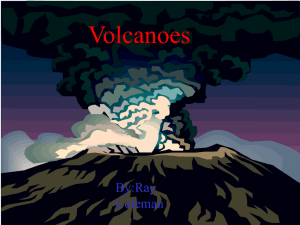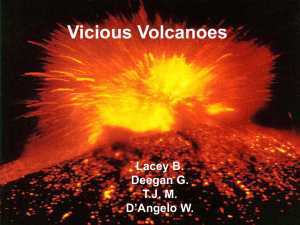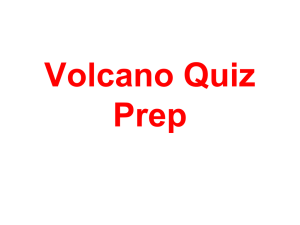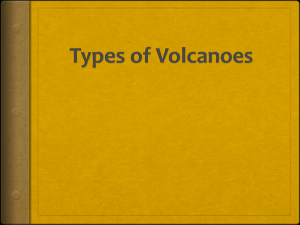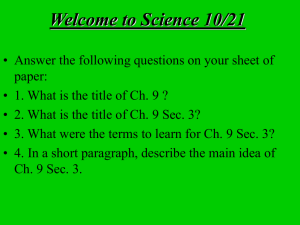Parts of the Volcano
advertisement
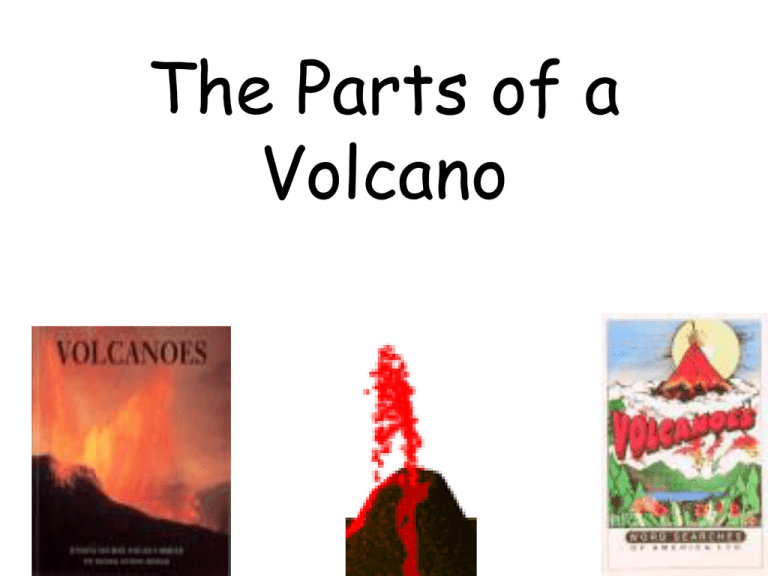
The Parts of a Volcano Today’s Journey • 0507.7.1 Create a model to illustrate geologic events responsible for changes in the earth’s crust. • 0507.7.2 Prepare a chart to compare how volcanoes, earthquakes, faulting, and plate movements affect the earth’s surface features. • State Performance Indicators • SPI 0507.7.1 Describe internal forces such as volcanoes, earthquakes, faulting, and plate movements that are responsible for the earth’s major geological features such as mountains, valleys, etc. What is a Volcano? A volcano is a mountain that forms when magma reaches the surface of the Earth. Magma rises because it is less dense than the solid rock around it. What are the parts of a Volcano? 1. VENT- the vent is the opening from which lava flows. Dust, ash, and rock particles can also be thrown out of the vent! 2. Crater- the top of the volcano. It is a funnel shaped pit. It is formed when the material explodes out of the vent! 3. Volcanic coneis the pile of lava, dust, ashes, and rock around the vent. It can be found in different shapes! Types of Volcanoes • There are 3 types of Volcanoes: Shield Cinder Cone Composite • They are classified by how they form. Shield Volcano • Is wide and somewhat flat. • It forms from a quiet eruption. • Lava flows out quietly and for great distances. • Made from divergent boundaries. • Divergent boundaries are places where two of Earth’s plates move apart. Shield volcanoes generally form at divergent boundaries, such as an ocean floor spreading center. Shield volcanoes generally have a smooth, broad, low shape with gentle sloping sides. Hotspots • Hotspots are unusually hot areas beneath a plate, where narrow plumes of magma rise from Earth’s mantle (asthenosphere) to the surface. • Shield volcanoes often form at hotspots. Composite Volcano “Strato” volcano Form from explosive eruptions. Produce a lot of lava and ash. Is small, with steep sides. Form at subductive (convergent) boundaries. Convergent boundaries are places where two of Earth’s plates crash together. Composite or “strato” volcanoes form at convergent boundaries. Composite volcanoes have rugged, steep sides and are made up of layers of lava and ash. Cinder Cone Volcano Has tall, very steep sides. Has explosive eruptions. This eruption produces a lot of cinder and ash. Cinder cone volcanoes can occur at both types: Subductive(convergent) and divergent boundaries! 20.2 Where you find volcanoes • About half of the active surface volcanoes on Earth occur along the shores of the Pacific Ocean. • This region is called the “Ring of Fire.” What is the Ring of Fire? 20.2 Where you find volcanoes • The Ring of Fire is found where the oceanic crust of the Pacific Plate is subducting under nearby plates. • Most volcanoes are located along plate boundaries. • Volcanoes, like those in Hawaii are also present along divergent boundaries and within plates. Today’s Journey • 0507.7.1 Create a model to illustrate geologic events responsible for changes in the earth’s crust. • 0507.7.2 Prepare a chart to compare how volcanoes, earthquakes, faulting, and plate movements affect the earth’s surface features. • State Performance Indicators • SPI 0507.7.1 Describe internal forces such as volcanoes, earthquakes, faulting, and plate movements that are responsible for the earth’s major geological features such as mountains, valleys, etc.




